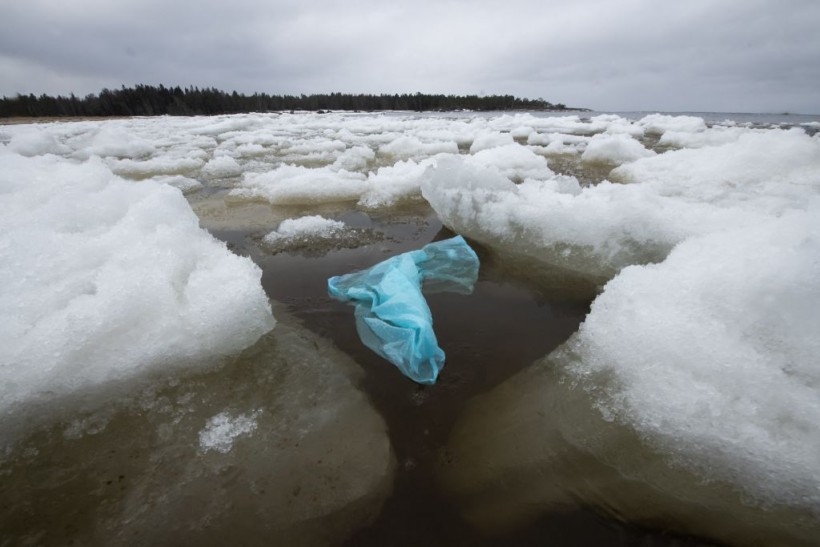Plastic is one of the most widely used materials in the world, with applications in various sectors such as packaging, construction, transportation, and electronics.
However, plastic also poses a serious threat to the environment, as it does not biodegrade easily and can persist for long periods in different ecosystems.
Plastic can break down into smaller pieces, known as microplastics, which are defined as plastic particles smaller than five millimeter in size.
Microplastics can be either primary, meaning they are intentionally produced or used as such, or secondary, meaning they are derived from the fragmentation of larger plastic items.
They have been detected in various environments, including freshwater, marine, terrestrial, and even atmospheric systems.
They can be transported by wind, water currents, or animals over long distances and reach remote areas that are otherwise pristine and untouched by human activities.
One of these areas is the Arctic, which is considered to be a hotspot for microplastic accumulation due to its cold climate, low population density, and the presence of polar gyres that trap floating debris.
However, the extent and nature of microplastic pollution in the Arctic are still poorly understood, as there are limited studies and data available on this topic.
Moreover, conducting research in the Arctic is challenging and costly, as it requires specialized equipment, logistics, and permits.
Therefore, there is a need for alternative and innovative methods to collect and analyze microplastic samples from the Arctic region.
One of these methods is citizen science, which involves the participation of non-professional volunteers in scientific projects.
Citizen science can offer several benefits for both researchers and citizens, such as increasing the spatial and temporal coverage of data collection, enhancing public awareness and engagement in environmental issues, and fostering collaboration and learning among different stakeholders.
Citizen Science in the Arctic
Tourists acting as citizen scientists have helped a research team detect microplastics on remote Arctic beaches, as per Phys.org.
The global scale of plastic production means that these tiny fragments of plastic are now ubiquitous, and scientists fear that ocean currents will cause the plastic to accumulate in the Arctic, damaging ecosystems. But our knowledge of the scale and type of plastic pollution in the Arctic is incomplete.
Researchers recruited holidaymakers to carry out sample collection during cruises, hoping to fill in some of the gaps in their knowledge
The Svalbard archipelago is Europe’s northernmost landmass-beautiful, remote, and at risk from microplastics transported by ocean currents.
Four tourist cruises visiting Svalbard in 2016, 2017, 2021, and 2022 collected sediment samples: all cruises except 2022 also surveyed macroplastic debris (between 2.5 and 10cm in size) for a different study.
Initially, single samples were taken from beaches using simple metal tools and sent to the scientists with metadata and photographs to record sampling locations. Later this was expanded to cover whole beaches with a sampling grid.
Microplastic sources and impacts
These samples were dried out, weighed, and measured. Each sample was filtered to capture particles 1mm or larger in size, as per Frontiers.
This boundary was selected on the basis that smaller particles don’t easily become airborne, an assumption that the scientists tested by keeping a bowl of purified water next to their worksurface and filtering it to search for microplastics after their analysis was complete: no microplastics had drifted from the laboratory’s air into the water.
To avoid plastic contamination, the scientists ran an air purifier, wore cotton lab coats, avoided synthetic clothing, and covered samples with aluminum lids.
Identified plastic particles were examined under a microscope and then analyzed using spectroscopy.
The scientists found that microplastics of the size they were searching for were not widespread but were very concentrated: the estimated overall level of plastic pollution was comparable to areas formerly believed to be much more polluted than Arctic beaches.
Two specific sources of plastic pollution were identified in their samples: polypropylene fibers that likely formed part of a fishing net, and polyester-epoxide particles that probably came from a ship’s color coating or equipment.
The researchers warned that microplastics can have negative impacts on marine life and ecosystems, as they can be ingested by animals or accumulate toxins that can be transferred up the food chain.
They also suggested that microplastics can alter the physical properties of sediments, such as water retention and permeability.
They call for more research on the sources, pathways, and effects of microplastics in the Arctic, as well as measures to reduce their production and consumption.




